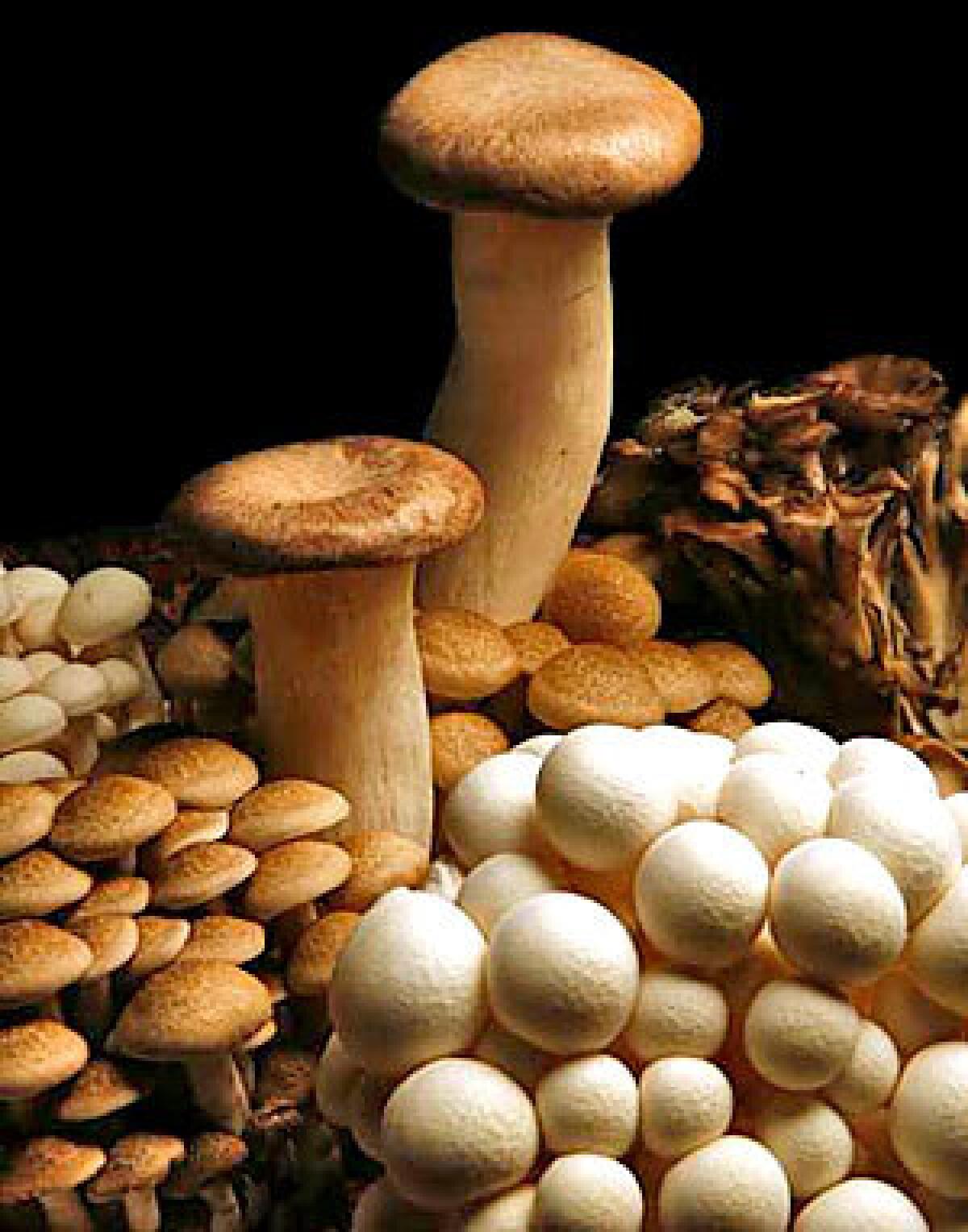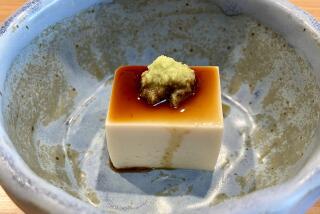Once-exotic mushrooms -- king trumpets, maitake and shimeji -- get ready to rise on Southern California turf

KING trumpets that have a texture almost as firm and meaty as young porcini; shimejishimeji that have a flavor that is wonderfully nutty; hen of the woods with a taste as earthy as their name. If you still think the cutting edge in grocery store mushrooms is enoki, shiitake and portobello, you’ve got some very pleasant surprises coming.
And if one Southern California partnership has its way, there are going to be plenty of those surprises available too.
In San Marcos, just north of San Diego, the Japanese mushroom giant Hokto Corp. is working with its American partner, Golden Gourmet Mushrooms, to build a massive, Space Age growing facility that within just a couple of years will be producing as many as 6 million pounds of these exotic mushrooms annually.
That’s more than triple the amount of king trumpets, shimeji and hen of the woods sold in the United States last year. And though, according to the USDA, they represent less than 1% of all fresh mushroom sales (more than 675 million pounds last year), they’re part of a segment that is increasingly profitable.
Though sales of the common button-type mushrooms have been mostly flat for the last five years, specialty mushroom sales increased 9% last year in spite of an average cost that’s more than double the cost of buttons. “In the big picture, we’re a fly on an elephant’s behind,” says Golden Gourmet President and Chief Executive Craig Anderson. “But it’s been the biggest growth area in the industry.”
Though today you’ll rarely find trumpets, shimeji or hen of the woods at mainstream groceries, at Asian markets in Southern California they are year-round staples, almost as common as buttons. And for a specialty ingredient, they’re surprisingly inexpensive -- usually less than $10 a pound.
As is common with mushrooms, each of these specialty varieties may be found under several names.
The king trumpets are also called king eryngii, or king oysters (technically they’re Pleurotus eryngii, and are closely related to the common oyster mushroom, Pleurotus ostreatus). King trumpets are almost all stem and are large -- commonly 3 or 4 inches long and sometimes as many as 6 or 7. Their texture is firm and meaty and their flavor is mild.
Shimeji (Hypsizygus marmoreus or tessulatus), also called beech mushrooms, look like oversized enoki. However, while the latter are cute but basically flavorless, shimeji have a delicious nutty taste. They come in either white or brown.
Perhaps the most deeply flavored of these mushrooms is the hen of the woods or maitake (Grifola frondosa). Though it isn’t as attractive as the king trumpet or shimeji -- it pretty much looks like something you’d find sprouting from the forest floor -- it has a robust earthy, woodsy flavor that is superb.
More than 95% of the mushrooms sold in the United States are from the agaricus family, whether they are common white or brown buttons, the slightly larger cremini or the huge portobello. In reality, those are all very closely related mushrooms harvested at various points in their growth.
Agaricus mushrooms are so popular because they are so easy to grow. Though plants grow in the earth, mushrooms are grown on different bases, called substrates. Sometimes this is very simple. Agaricus will thrive even on straw.
Other mushrooms such as oysters and shiitakes grow on dead logs, making them only a little more difficult to cultivate. The specialty mushrooms Hokto is growing take that a step further, growing on a specially composed substrate -- primarily sawdust, ground corncobs and wheat and rice bran.
The holy grail of fungi culture is the cultivation of such treasured wild mushrooms as chanterelles, porcini, morels and truffles. Though experiments are ongoing and hope springs eternal, this is an exceedingly difficult process because these are mycorrhizal mushrooms. That means they grow only in community with the root systems of living trees, something that is much harder to manage on a commercial scale.
Waste not, want not
OF COURSE, farming mushrooms is nothing new. They’ve been cultivated for centuries and the introduction of large-scale mushroom growing in the U.S. dates to the 1890s.
It started in the little town of Kennett Square, Penn. -- not far from Philadelphia -- where a Quaker carnation grower named William Swayne began growing mushrooms in the dark areas under the growing tables in his greenhouses.
Because of the town’s proximity to the major markets of Philadelphia, Pittsburgh, Baltimore, Boston and New York, this soon became a thriving regional business.
It was also a pioneer in recycling. In those days, most public transportation was by horse, and cleaning up after the beasts was a major problem in urban areas. Since these fungi grow well on straw and manure, the wagons would leave Kennett Square loaded with mushrooms and return loaded with the material with which to grow more.
To this day, even though transportation is not the same sort of issue and horse manure is no longer widely used for growing, Pennsylvania still accounts for more than half of all the cultivated mushrooms grown in the United States. California ranks second with less than 20%.
Hokto’s plant in San Marcos is as far removed from Swayne’s operation as a rocket ship is from a horse and buggy.
The plant is located at the end of a valley that looks like it has seen better days. You approach the building on a dusty road. Then you make a turn and there it is: metallic white and gleaming in the sun.
It’s huge -- 250,000 square feet spread across two floors. And it’s hugely expensive. Though the company won’t talk about specifics, officials acknowledge that by the time everything is up and running it will have cost at least $50 million.
The operation is terrifically ambitious, even for Hokto, a company that has 25 mushroom-growing facilities in Japan. There, each operation grows only one kind of mushroom, either maitake, shimeji or king trumpet. Here, they’re growing all three.
In its rough outlines, the process is similar for all of the mushrooms, but each type requires its own set of specific circumstances including temperature and humidity and will have its own zone in the new building.
From the mixing of the substrate to harvesting and packaging, the process is entirely automated and the mushrooms are never touched by human hands. They are grown in plastic bottles, following a technique developed by Hokto in Japan (they switched from glass after the 1964 Niigata earthquake).
The bottles are first filled with the substrate, which is then inoculated with mushroom culture. Over a period of weeks this creates a root system called mycelium in the bottle and eventually, given the right conditions, that root system begins to produce mushrooms. Depending on the variety, this can take from 1 1/2 to two months for maitake and king trumpet, to more than three months for shimeji.
Reuse, recycle
THE mushrooms will all be certified organic and the plant in San Marcos is designed to be almost astonishingly green. The spent substrate, already mostly recycled material, but now enriched by the mycelium, will be recycled yet again for animal feed and other agricultural uses and the bottles will be reused on the next crop. The only waste product will be distilled water from the sterilization process.
Furthermore, the plant is so energy efficient that it has qualified for a $500,000 rebate from San Diego Gas and Electric, the largest in the utility’s history.
Right now, the mushroom-growing process is just beginning. The first run of bottles is being inoculated and the first mushrooms probably won’t be ready to sell until early next year. In the meantime, the company is selling mushrooms from its Japanese plants under the Hokto and Golden Gourmet labels.
The first year’s production goal is ambitious: 4 million pounds. To do that, Anderson says, they’re going to have to break out of their old markets and into the mainstream.
That could be a challenge in a country where mushroom eating has always been a little outside the mainstream (Anderson describes the U.S. as “mycophobic”). But, he says, headway is being made. “It used to be I’d hear, ‘Was it raised in [manure]? Will I see colors if I eat it? Will I die because they’re poisonous?’
“Those are the hurdles we have had to overcome. It’s been an uphill battle, but we’re gaining traction.”
One thing that should work strongly in these specialty mushrooms’ favor is their rich flavor. Not long ago, portobellos went from being a growers’ mistake (they’re actually just over-mature creminis) to being one of the hottest items in the produce section because of their meaty taste.
These mushrooms have the same potential. Though they won’t begin appearing in great numbers until early next year, they are in Asian markets such as Mitsuwa, 99 Ranch and Marukai right now. And since fall seems like the perfect season for mushroom eating, you might as well get started.
Maximizing flavors
AS WITH any mushroom, high heat when cooking is the key to getting the best taste. Mushrooms are very high in moisture and it takes that kind of temperature to concentrate the juices and begin the browning process.
This is particularly true of the shimeji and maitake mushrooms, which really need to be cooked well to get the best taste. Though their flavors are different in nuance, they can be used interchangeably.
The place they really differ is in appearance. So if you’re going to be cooking something where the mushrooms need to look nice -- such as the topping for the halibut baked in parchment -- the shimeji are a better choice.
On the other hand, the maitake mushrooms, though cosmetically disadvantaged, have a really rich, woodsy flavor. Use them for dishes where looks aren’t so important -- pureed in a soup for example, or as a filling for lasagna or crepes.
King trumpets are the only ones of this group that are good raw, and they are very good indeed, with a meaty texture and mild, slightly briny flavor. Cooking them doesn’t seem to improve the flavor much, but they do pick up a nice delicate crust if you sear them well.
Serve these as you would young, firm porcini: slice them thin (lengthwise so you get the full effect of their size). Strew them across a bed of lightly dressed arugula greens. Shave Parmigiano-Reggiano in long, thin strips over the top and finish with a scattering of toasted pine nuts.
Then take just a moment to revel in the thought that fairly soon, once-exotic mushrooms such as these may be as close as your neighborhood supermarket.
More to Read
Sign up for The Wild
We’ll help you find the best places to hike, bike and run, as well as the perfect silent spots for meditation and yoga.
You may occasionally receive promotional content from the Los Angeles Times.











